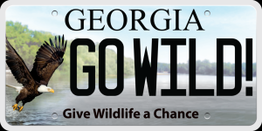
Wildlife conservation centers on living creatures and natural communities.
But the announcement this month of a new eagle license plate (above) vital to conserving Georgia’s nongame wildlife, as well as two other tags that benefit DNR programs, highlights a less organic side:
Numbers.
Here are 10 tied to nongame that may amaze you:
1.95
Dollars received in grant or other matching funds for every $1 spent from the Georgia Nongame Wildlife Conservation Fund from 2008-2012.
60
Percentage of Wildlife Conservation Fund revenue provided by nongame wildlife license plates since 1997.
65
Percent drop in nongame plates in circulation since legislators changed specialty plate fees in 2010.
90
Percent decline in wildlife plate sales since the 2010 changes.
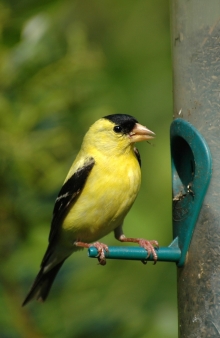 175
Percent increase in people watching wildlife away from home in Georgia from 2001-2011, according to a U.S. Fish and Wildlife Service survey.
1,000+
Plant and animal species in Georgia considered species of conservation concern.
1,900,000
People who watched birds in Georgia in 2011.
2,206,000
Georgians involved in any aspect of wildlife watching – observing, photographing or feeding wildlife – in 2011. (Nearly 2.4 million state residents and non-residents watched wildlife in Georgia.)
1,802,425,000
Expenditures ($1.8 billion) by all wildlife watchers in Georgia, residents and non-residents, in 2011.
2,557,474,000
Expenditures ($2.5 billion) by Georgians watching wildlife in the state and out in 2011. (Expenditures by Georgia anglers totaled $708.5 million, and by Georgia hunters, $752.3 million.)
These stats intersect at nongame wildlife, native animals and plants such as songbirds and rare pitcherplants not hunted, fished for or harvested. Nongame makes up the majority of Georgia wildlife.
Conserving rare and other nongame not only benefits game species, it feeds watchable wildlife’s multibillion-dollar economic impact in the state and the outdoors recreation that 2.2 million Georgians enjoy.
Nongame conservation is fed, in turn, by fundraisers such as the bald eagle and the hummingbird license plates. Without enough sales and renewals, the Nongame Wildlife Conservation Fund suffers. That undercuts DNR’s Nongame Conservation Section, which receives no state money for conserving nongame but depends on the fund.
For nongame wildlife in Georgia, it’s a matter of making the numbers work.
Learn more in our annual report.
|
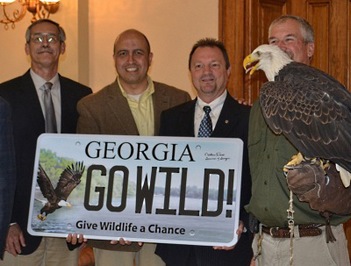 Why buy a plate?
-
Do the bald eagle and hummingbird license plates still provide significant support for the Georgia Nongame Wildlife Conservation Fund? Yes. The $10 donated to the fund each time a plate is sold or renewed adds up to hundreds of thousands of dollars. For a plate kept five years, the fund receives $50, compared to $22 under the previous fee structure.
-
Do wildlife plates promote conservation? Yes. Consider them bumper billboards.
-
Can I make a direct donation to the Nongame Wildlife Conservation Fund, or provide support in other ways? Certainly. Here’s how.
(Note: Specialty plates cost $60 more than a standard plate when bought and $35 at renewal, not including taxes and the $20 registration fee charged for all plates, standard or specialty, when issued and annually.)
-
See more photos from the news conference where Gov. Deal unveiled the new wildlife plates.
|
Award-winning plant conservation
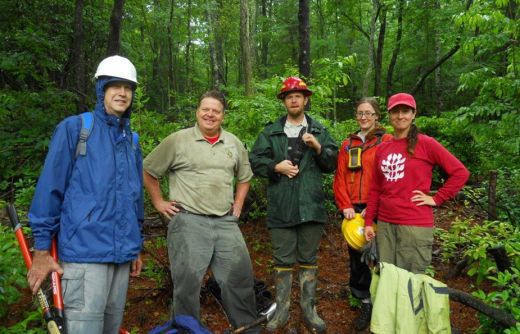
News that the Georgia Plant Conservation Alliance had received the American Public Garden Association’s annual Award for Program Excellence was more confirmation than shock for alliance members.
The conservation network known as GPCA has made headway helping Georgia’s at-risk plants since 1995.
The 31 members, varying from DNR to the Atlanta and State Botanical Gardens, blend expertise, outreach, coordination and regulatory authority. About 140 trained volunteers called Botanical Guardians serve as foot soldiers. Successes range from the field – where 27 rare species have been planted in safeguarding sites – to the greenhouse, where 55 rare plant species are being cultivated and studied. At least four states have modeled their networks after GPCA. Since its creation, the alliance and its members have also provided about $1.5 million in direct and indirect services for conserving plants, according to the State Botanical Garden.
The American Public Gardens honor placing the alliance alongside former recipients such as Missouri Botanical Garden and Smithsonian Institution simply underscores GPCA’s record and mission.
The mission is about forging partnerships that provide the knowledge, land and resources to tackle needed, science-based plant conservation and education projects across the state. The record, suggests Dr. Mincy Moffett, botanist and DNR’s GPCA liaison, is about sweat and single-mindedness.
“Everybody has rolled up their sleeves and is really striving to work for the betterment of plant conservation,” Moffett said.
A recent GPCA work day in Union County (above) offered a snapshot. The focus was mountain bogs, mucky wetlands that rate as one of the Southern Appalachians' most endangered habitats. Yet here alliance-driven projects have resulted in generations of rare plants reproducing in the wild, a conservation milestone.
The group this day included U.S. Forest Service, DNR and State Botanical Garden staff, plus volunteers from the Atlanta Botanical Garden, Chattahoochee Nature Center and Youth Conservation Corps’ Generation Green. Workers monitored the status of rare plant species such as state-protected Carolina bog laurel, planted pitcherplants (some of the bogs’ larger ones were planted in 1998) and weighed alternative methods for keeping out hogs and deer.
The scope, from the agency mix to plantings born of research into how, when and where, was pure GPCA.
Peter White, director of North Carolina Botanical Garden, called what he sees in GPCA “robust and uplifting," adding "... It is about people and the good they can do when they work together."
GPCA at a glance

-
Formed in 1995 by the State Botanical Garden, Callaway Gardens, Atlanta Botanical Garden, DNR’s Nongame Conservation Section, the U.S. Forest Service and The Nature Conservancy of Georgia. (Safeguarding and other plant conservation was ongoing in Georgia before, much of it by DNR’s Tom Patrick and Ron Determann of Atlanta Botanical Garden.)
-
Organizational effort led by Jennifer Ceska, who studied the New England Wildflower Society's conservation network and wrote her master’s thesis on forming such an organization in Georgia.
-
Alliance lists 31 gardens, organizations, universities and agencies working together on more than 70 rare and endangered plant species in Georgia. Organizations vary from the U.S. Fish and Wildlife Service to Zoo Atlanta, Brenau University, Georgia Power and the Georgia Native Plant Society.
-
Supported by Botanical Guardians, trained citizen volunteers who help monitor and restore imperiled native plant populations.
-
Outreach includes State Botanical Garden’s Certificate in Native Plants Program, designed to train Botanical Stewards (so-called “super” Botanical Guardians).
-
Conservation efforts reflect high-priority species and habitats in the State Wildlife Action Plan, a comprehensive strategy for wildlife conservation in Georgia. GPCA's safeguarding program works on at least 40 high-priority species.
|
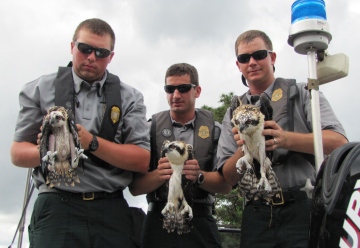 Noteworthy
Extra credit may be due the DNR rangers who, while training in a boat operators course recently at Lake Walter F. George, rescued three ospreys. Jordan Crawford, Mark Puig and Patrick Gibbs (pictured, from left) were returning to the marina when they spotted three juvenile ospreys sitting in the remains of nest in the water. Storms that morning had apparently blown the nest into the lake. The rangers caught the birds and put them in a new nest that other rangers built in a nearby tree. “The next day,” writes Puig, “we observed the mother going to nest to feed the ospreys. Success!” More photos on Facebook.
Let’s hear it for loggerheads. As of June 20, Georgia’s primary nesting sea turtle had 864 nests. That compares to 1,051, 1,044 and 757 nests, respectively, during the same period in the last three seasons, according to Sea Turtle Program Coordinator Mark Dodd. Each of those seasons topped 1,700 nests by summer’s end and set a state record. (The new mark is last year’s 2,241 nests.) Despite a late start, nesting in 2013 could again exceed 1,700 nests and has the potential to reach 2,000. Updates.
With shrimping season on, Nongame biologists monitored trawling from the air on the June 11 opening day in state waters and DNR rangers continue to check shrimpers for compliance, including the required use of turtle excluder devices. Dodd notes that trawler mortality is a major threat to the recovery of loggerhead populations. So far, the number of stranded sea turtles has been low since the opener.
 A group of Georgia teens was immersed in coastal birding this month through Camp TALON, a Charlie Elliott Wildlife Center outreach held with the Georgia Ornithological Society and Atlanta Audubon Society. Led by Charlie Elliott’s Julie Duncan and Bob Sargent of the Ornithological Society, campers birded at barrier islands like Little St. Simons, Blackbeard and Sapelo, and spent evenings at hot spots such as Gould’s Inlet and Altamaha Waterfowl Management Area. Learn more about Charlie Elliott camps.
Georgia teachers who pack energy, innovation and nongame wildlife into teaching life-science standards to third- through fifth-grade students are encouraged to apply for a $1,000 education grant from the Nongame Conservation Section. The grant provided by TERN, friends group of Nongame Conservation, is aimed at helping them with a specific classroom project.
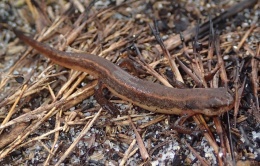 The reintroduction of striped newts to Apalachicola National Forest in Florida added another success last week. Researchers captured their first newly metamorphosed striped newt (left) moving out of a repatriation pond, bound for the uplands, writes ecologist Ryan Means of the Coastal Plains Institute and Land Conservancy. A pond at Georgia’s Fall Line Sandhills Wildlife Management Area provided larvae for the Apalachicola effort (“Fall Line powers projects,” May 2011).
Lights, camera … Nongame biologist Thomas Floyd has been on-cam this month, capturing and discussing hellbenders for a show by British survivalist Ray Mears and explaining bog turtles (as he fitted one with a transmitter) for a Georgia Outdoors episode on north Georgia wetlands. Both projects could be broadcast next year, Mears’ footage as part of a series on how North America’s geography shaped the “Wild West.”
A bear carcass found on a North Carolina road last week with “WHATS BRUIN?” in white paint across its head and similar wording on its paws has spurred a $3,000 reward for information leading to an arrest and conviction. Ten people were convicted earlier this month on federal charges stemming from Operation Something Bruin, a four-year, multiagency undercover investigation into poaching in North Carolina and Georgia (video). Other cases are being prosecuted.
Unusual or out-of-place birds have been turning heads this spring. Sightings vary from gulls circling the
Gateway Shopping Center in Thomasville to white pelicans hanging out at a Floyd County lake, swallow-tailed kites in DeKalb and Clarke counties, and scissor-tailed flycatchers nesting near Watkinsville, the first time the species has been documented in Oconee County.
|
Parting shot
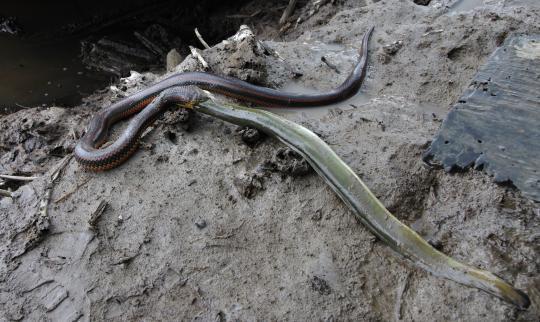 How much eel could a rainbow snake eat if a … OK, the rhyme doesn’t work but these photos of a rainbow snake consuming a large eel on the lower Savannah River raises the question. Savannah National Wildlife Refuge biologist Chuck Hayes spotted the snake on a tributary bank in late May. Okefenokee-based U.S. Fish and Wildlife Service botanist Forbes Boyle and intern Conor Egan photographed it. Though considered one of the most beautiful snakes, rainbow snakes are rarely seen, spending most of their lives hidden in aquatic vegetation. They’re nicknamed eel moccasins because they like to eat eels. As Boyle quipped, “It was an awesome snake to observe, so closely, and dining on its favorite meel.”
And in case you’re wondering, Nongame biologist John Jensen said, yes, this rainbow snake can eat this eel. If not, it could regurgitate the super-sized dinner. Jensen, lead author of “Amphibians and Reptiles of Georgia” (UGA Press), adds that the legend of the hoop snake – a mythical species that rolls into a hoop to chase people, packing a venomous stinger on its tail – is linked to mud and rainbow snakes because of the long prey those species favor. “They can’t fold them up or bite them into pieces so the prey fills up most of their long, linear gut,” Jensen writes. “As a consequence, they cannot coil tightly like most snakes but instead bask (to speed digestion) in a big, loose hoop rather than concentric coils.” Hoop snake history.
Headlines
"New tags benefit state wildlife efforts," The Atlanta Journal-Constitution (and others, including WXIA-TV/11Alive)
"American Public Gardens Honors Georgia Plant Conservation Alliance," The Outdoor Wire
"Birdwatchers twitching with excitement over new species in Cambodia," CNN
"Scientists find proof plants are capable of complex arithmetic," The Telegraph (United Kingdom)
(+video) "A glamorous killer returns," The New York Times (on eastward expansion of cougars)
(+video) "Bears not a nuisance in Rome," Rome News-Tribune
"Bullfrogs may help spread deadly amphibian fungus, but also die from it," Oregon State University
"10 sentenced in N.C. bear-hunting operation," Charlotte Observer
"Zoo hosts hellbender symposium," Chattanoogan.com
(+video) "Bald eagles poisoned in Thibodaux," WAFB-TV (Baton Rouge, La.)
"Paddlers start 106-mile trip," The Albany Herald
"The ethical flap over birdsong apps," National Geographic
Credits
** Masthead: Rangers place rescued ospreys in the new nest at Lake Walter F. George. Jay Bright/Ga. DNR
** Goldfinch at feeder. Todd Schneider/Ga. DNR
** From left, Nongame Conservation Section Chief Mike Harris, artist Omar Murcia, THP Creative Group owner Jefferson Riley and DNR wildlife interpretive specialist Pete Griffin show the bald eagle plate unveiled along with new quail/deer and trout tags by Gov. Nathan Deal June 13.
** GPCA mountain bog crew including, from left, Atlanta Botanical Garden volunteer and GPCA Botanical Guardian Bob Holmes, Nongame's Mincy Moffett, Mike Brod of the Forest Service, former Nongame botany assistant Carrie Radcliffe and GPCA coordinator Jennifer Ceska.
** Montane pitcherplants. Linda May/Ga. DNR
** Rangers, from left, Jordan Crawford, Mark Puig and Patrick Gibbs with young ospreys. Jay Bright/Ga. DNR
** Striped newt eft at Apalachicola. Ryan Means/Coastal Plains Institute and Land Conservancy
** Rainbow snake eating an eel. Conor Egan/U.S. Fish and Wildlife Service
Give wildlife a chance!
The Nongame Conservation Section of Georgia DNR receives no state funds to conserve nongame wildlife, native plants and natural habitats. Instead, we depend on contributions, grants and fundraisers, such as the eagle and hummingbird license plates.
How can you help?
|